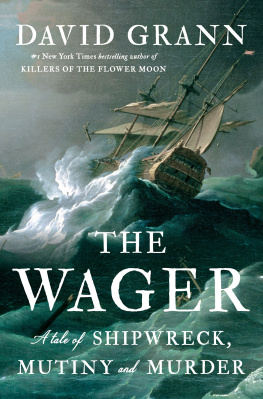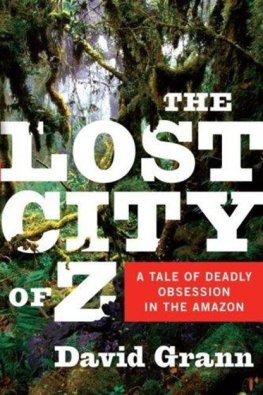Praise for David Granns
The Devil and Sherlock Holmes
These straightforward tales grip you as unrelentingly as the suckered appendages of the giant squid Grann attempts to track down in The Squid Hunter. Entertainment Weekly (Grade: A)
Titillating. Evidence of Granns abundant talent as a writer.Providence Journal
The most powerful essay I read this year was David Granns Trial by Fire. David Brooks, The New York Times
The truth is always stranger than fiction, even when it comes to murder mysteries. Thats the take-home lesson of Granns latest collection, which brings together twelve stories of real-life mysteries, each one stranger and more gripping than the last.The Daily Beast
A gifted storyteller, Grann has a Sherlock Holmesian gift for unearthing facts that are hidden in plain sight, presenting a crystal-clear narrative and letting his compelling cast of characters speak for themselves. Easily worth the price of admission, a visit to Granns rogues gallery is likely to leave you with a sense, at once awful and awesome, of the profound desire we all have for recognition.The Oregonian
Beautifully constructed, highly improbable real life reports.GQ (UK)
Eclectic. Skilfully crafted. [Grann] does not just tell these bizarre tales, he meets, interviews, gets to know and seems to understand many of his strange subjects.The Irish Times
There is humanity in the writing, and its all the more impressive that Grann manages to evoke it without drawing any attention to himself; his tales are first-person ones, but they dont foreground the writer in that manner so popular among magazine editors today. Indeed, his selflessness as a writer, along with his gentle rectitude, cause him to bear a resemblance to another hero who never hogs the spotlight: Holmess assistant, Watson. Rarely does modesty produce such stunning results.Bookforum
Thoroughly documented, well written and full of surprises.Toronto Star
Granns in-depth reporting and vivid writing make this worthwhile reading for lovers of good journalism.BooklistChilling. Poignant. Haunting and gripping. Gets into worlds that are otherwise invisible to us.Daily Mail (London)Grann is a worthy heir to Truman Capote.Le Monde (Paris)

David Grann
The Devil and Sherlock Holmes
David Grann is a staff writer at The New Yorker and author of the #1 New York Times bestseller The Lost City of Z, which has been translated into more than twenty-five languages and received the Indies Choice Book Award for the best nonfiction book of 2009. He is a recipient of the George Polk Award for magazine reporting, and has written for The New York Times Magazine, The Atlantic, The Washington Post, The Wall Street Journal, and The New Republic.
www.davidgrann.com
Also by David Grann
The Lost City of Z

FOR ZACHARY AND ELLA

Introduction
Reporting, like detective work, is a process of elimination. It requires that you gather and probe innumerable versions of a story until, to borrow a phrase from Sherlock Holmes, the one which remains must be the truth.
Although Holmes is the subject of just one of the stories in this collection, about the curious death of the worlds foremost Holmes expert, all twelve contain elements of intrigue. Many of the protagonists are sleuths: a Polish detective trying to determine whether an author planted clues to a real murder in his postmodern novel; scientists who are stalking a sea monster; a con man who suddenly suspects that he may be the one who is being conned. Even the stories that seem cut from a different cloth deal in mystery of a kind: the secret world of sandhogs digging water tunnels under New York City, or the riddle of an aging but ageless baseball star.
Unlike the adventures of Sherlock Holmes, these tales are all true. The protagonists are mortal: as with Dr. Watson, they can see, but they dont necessarily observe. Pieces of the puzzle often remain elusive. Their stories do not always end happily. Some of the characters are driven to deception and murder. Others go mad.
Part of Holmess appeal is that he restores order to a bewildering universe. But it is the messiness of life, and the human struggle to make sense of it, that drew me to the subjects in this collection. As Holmes once conceded to Dr. Watson, If we could fly out of that window hand in hand, hover over this great city, gently remove the roofs, and peep in at the queer things which are going on, the strange coincidences, the plannings, the cross-purposes, the wonderful chains of events, working through generations, and leading to the most outr results, it would make all fiction with its conventionalities and foreseen conclusions most stale and unprofitable.
When I began investigating these stories, I knew almost nothing about them. Many originated from little more than a tantalizing hint: a tip from a friend, a reference buried in a news brief. While I tried to unearth the facts and reveal the hidden narrative, I occasionally found myself baffled by a clue or a missing piece of evidence. Yet in the end these stories seemed to provide at least glimpses of the human condition, and why some people devote themselves to good and others to evil. As Holmes put it, Life is infinitely stranger than anything which the mind of man could invent.
Part
One

Any truth is better than indefinite doubt.
SHERLOCK HOLMES, in The Yellow Face

Mysterious Circumstances

 THE STRANGE DEATH OF A SHERLOCK HOLMES FANATIC
THE STRANGE DEATH OF A SHERLOCK HOLMES FANATIC

Richard Lancelyn Green, the worlds foremost expert on Sherlock Holmes, believed that he had finally solved the case of the missing papers. Over the past two decades, he had been looking for a trove of letters, diary entries, and manuscripts written by Sir Arthur Conan Doyle, the creator of Holmes. The archive was estimated to be worth nearly four million dollars, and was said by some to carry a deadly curse, like the one in the most famous Holmes story, The Hound of the Baskervilles.
The papers had disappeared after Conan Doyle died, in 1930, and without them no one had been able to write a definitive biographya task that Green was determined to complete. Many scholars feared that the archive had been discarded or destroyed; as the London Times noted, its whereabouts had become a mystery as tantalizing as any to unfold at 221B Baker Street, the fictional den of Holmes and his fellow-sleuth, Dr. Watson.
Not long after Green launched his investigation, he discovered that one of Conan Doyles five children, Adrian, had, with the other heirs agreement, stashed the papers in a locked room of a chteau that he owned in Switzerland. Green then learned that Adrian had spirited some of the papers out of the chteau without his siblings knowledge, hoping to sell them to collectors. In the midst of this scheme, he died of a heart attackgiving rise to the legend of the curse. After Adrians death, the papers apparently vanished. And whenever Green tried to probe further he found himself caught in an impenetrable web of heirsincluding a self-styled Russian princesswho seemed to have deceived and double-crossed one another in their efforts to control the archive.
Next page









 THE STRANGE DEATH OF A SHERLOCK HOLMES FANATIC
THE STRANGE DEATH OF A SHERLOCK HOLMES FANATIC